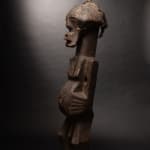Songye Wooden Bishimba Power Statue, 19th Century CE - 20th Century CE
Wood and Mixed Media
142.9 x 24.1 cm
56 1/4 x 9 1/2 in
56 1/4 x 9 1/2 in
PF.4705 (LSO)
Further images
-
(View a larger image of thumbnail 1
)

-
(View a larger image of thumbnail 2
)

-
(View a larger image of thumbnail 3
)

-
(View a larger image of thumbnail 4
)

-
(View a larger image of thumbnail 5
)

-
(View a larger image of thumbnail 6
)

-
(View a larger image of thumbnail 7
)

-
(View a larger image of thumbnail 8
)

-
(View a larger image of thumbnail 9
)

-
(View a larger image of thumbnail 10
)

-
(View a larger image of thumbnail 11
)

-
(View a larger image of thumbnail 12
)

This incredibly imposing sculpture of a standing man was made by the Songye people of what was once Zaire. It is in the conventional form but spectacularly larger than is...
This incredibly imposing sculpture of a standing man was made by the Songye people of what was once Zaire. It is in the conventional form but spectacularly larger than is common for such pieces. It stands upon an integral circular base with bent legs, angular block-section limbs, a protuberant abdomen, oversized hands, a columnar neck and a broad face narrowing to a square chin. The eyes are low-relief, with a straight nose and a square, open mouth. Detailing includes outsized male genitalia, an incised umbilicus and a tall (goat?) horn inserted into the top of the head with accompanying leather/fur. The entire surface is patinated with a glossy sheen indicative of age and use, and there are other signs – including stable cracks – of considerable age.
The Songye people are based in the Democratic Republic of Congo (formerly Zaire). They were founded in the 16th century following an exodus from the neighbouring Shaba area, settling near to the Lualuba River. There are around 150,000 Songye divided into subgroupings that are under the governorship of a central chief known as the Yakitenge. More local governance is in the hands of chiefs known as Sultani Ya Muti. Their economy is based upon agriculture and pastoralism.
The Songye are perhaps best known for their artworks, which are both institutional and domestic/personal in nature. Their best-known artefacts are masks created for members of the Bwadi Bwa Kifwebe. The word kifwebe means “mask” in Songye, and describes long-faced creations decorated with curvilinear designs. Crested examples are male, while plain-topped ones are female; these interact during masquerades to demonstrate the contrasting virtues of power (male) and familial values (female). The most impressive figural works are wooden sculptures that are usually decorated with feathers and other organic materials, and which are known as Bishimba. Their magical powers are contained within the horn that’s is usually inserted into the top of the head, which may contain objects such as organic residues, grave earth and biological objects such as feathers, claws or fur. The figures are often adorned with gifts in the form of furs, bells and other objects that are used to dress the figure; they also tend to receive libations, physical manifestations of appeals made for spiritual assistance.
This piece has clearly received such attentions, and judging from its size must have been a major focus for a large population. It is a very striking and important piece of African art.
The Songye people are based in the Democratic Republic of Congo (formerly Zaire). They were founded in the 16th century following an exodus from the neighbouring Shaba area, settling near to the Lualuba River. There are around 150,000 Songye divided into subgroupings that are under the governorship of a central chief known as the Yakitenge. More local governance is in the hands of chiefs known as Sultani Ya Muti. Their economy is based upon agriculture and pastoralism.
The Songye are perhaps best known for their artworks, which are both institutional and domestic/personal in nature. Their best-known artefacts are masks created for members of the Bwadi Bwa Kifwebe. The word kifwebe means “mask” in Songye, and describes long-faced creations decorated with curvilinear designs. Crested examples are male, while plain-topped ones are female; these interact during masquerades to demonstrate the contrasting virtues of power (male) and familial values (female). The most impressive figural works are wooden sculptures that are usually decorated with feathers and other organic materials, and which are known as Bishimba. Their magical powers are contained within the horn that’s is usually inserted into the top of the head, which may contain objects such as organic residues, grave earth and biological objects such as feathers, claws or fur. The figures are often adorned with gifts in the form of furs, bells and other objects that are used to dress the figure; they also tend to receive libations, physical manifestations of appeals made for spiritual assistance.
This piece has clearly received such attentions, and judging from its size must have been a major focus for a large population. It is a very striking and important piece of African art.











